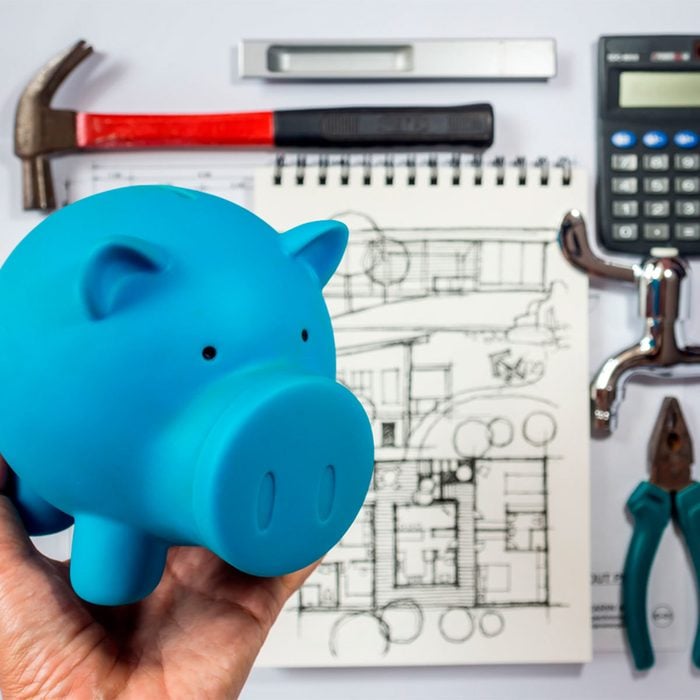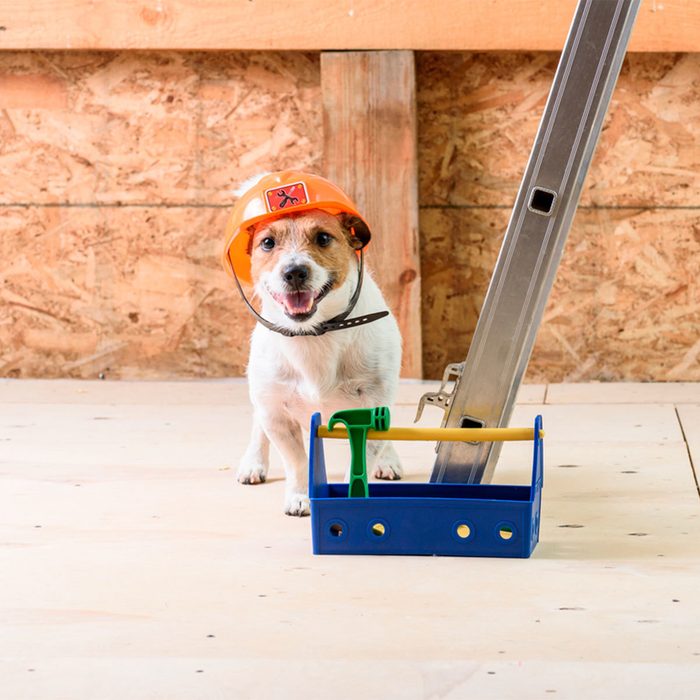1
/
20

Know Your End Goal
Before you decide how extensively to renovate, you need to know what your end goal is for your home. Are you renovating to raise the resale value of your home, or will you be staying put for years to come? Consider the condition of your neighborhood before you begin, and know which renovations are a good return on investment, and which will be considered overdoing it for the area. Having a specific plan in place for your future will help you decide how deep to go with your project.
2
/
20

Have a Budget
Knowing your budget—and sticking to it—is one of the most important parts of renovation planning. Remember to add in a contingency fund for any unexpected costs—and expect to use it—as well as incidental costs like the cost of eating out for a kitchen reno, or even taking a hotel for a night or two.
It can be easy to want a top-of-the-line renovation, but perhaps all you need are some cheap upgrades which will make your house look more expensive. Do your research and plan your budget before ever lifting a hammer.
3
/
20

Consult the Calendar
If you're hoping for a brand new home for a particular event or holiday, make sure you look at your end date and work your way backward. Be sure to pencil in a few weeks to a month at the end for wiggle-room in case there are delays on the way to avoid disappointment.
Plus: How to Complete a Renovation Without Getting a Divorce
4
/
20

Do Your Research
Take the time to chat with friends, family, and neighbors about the renovation work they have done, and the challenges they have faced during the process. Having a wealth of information from homeowners who have been in your shoes can be invaluable in the planning process, and this information may alter your end plan. Check out our 17 Smarter Renovation and Home Improvement Tips to get started.
5
/
20

Know Your Limits
DIY renos are a great way to save money, have a sense of accomplishment, and involve the entire family, but they can turn disastrous if you don't know what you're doing. Know which tasks you can safely tackle, and which should be handled like the pros, like a potentially load-bearing wall, asbestos or lead paint.
If you're feeling unsure, here's how to find a good contractor to help.
6
/
20

Ask for References
Any good contractor will have no problem providing references, and copies of liability insurance before a job begins. Don't rely solely on client testimonials, search out actual customers that can give you a firsthand account and answer any questions you may have. For any project, ask to see before and after images of a contractor's prior work, and most importantly—trust your gut and know which questions to ask.
7
/
20

Pack Up
To make any house remodel as simple as possible, declutter, pack up or move any items in the renovation zone. For a whole-home remodel, consider renting an offsite locker or onsite storage pod to keep all your belongings secure and clean during the process.
Plus: Tips for Moving Furniture
8
/
20

Consider Your Routine
If you're an experienced DIYer, you are likely good at working around the disruptions of a house remodel. However, if you've hired a contractor for any part of the job, be sure to be clear about your daily routine, and work with the contractor to come up with start and end times that cause the least disruption in your family's day. After all, no one wants to encounter tradespeople while you're still in your bathrobe.
9
/
20

Establish Mission Control
There's nothing more frustrating than being in the middle of a job when you can't find the tool you need. Before you begin your remodel, reserve an area of your home to act as mission control to keep all your tools, materials, manuals and checklists in one place.
Plus: Tips for Getting Your Garage Clean and Organized
10
/
20

Protect the Kids
A house remodel is a perfect way to get the kids involved in DIY, but for very little ones it can be dangerous too. Be sure to install child safety gates, electrical safety covers and store sharp tools well out of the way of curious tots, especially on off-hours where there may not be adequate supervision in the remodel zone.
11
/
20

Don't Forget the Pets
The temporary chaos of a home under renovation can be stressful at the best of times for the human occupants of the house, let alone the four-legged family members. When doing a house remodel, consider the safety and care of your pets, which could mean having a family member or friend pet-sit while the bulk of the work is getting done. This is especially true when the doors will often be open to bring tools and materials in and out.
12
/
20

Plan For Outages
If your home is lacking plumbing shut-off valves in the area you are working on, you may have to shut the water off at the main valve, leaving your home without access to running water. Plan ahead and place containers of water in the fridge for drinking, on the counter for cooking and have buckets of water available to flush the toilet. An easy way to do this is to fill the bathtub with water and place a bucket nearby to pour into the toilet bowl.
Plus: 10 Tips to Survive a Blackout
13
/
20

Make a Master List
To have the best chance of success, and to help in the budgeting process, make a master checklist of items you need, from administrative tasks like permits, right down to rollers for the paint. It's helpful to separate the list by items you have, and items you need to purchase. In the case of tools, making a list can help you decide which tools you can rent to save on costs versus purchasing new.
Plus: 10 Vital Home Maintenance Tasks You'll Regret if You Forget
14
/
20

Create Drawings
You don't have to be an engineer to create job drawings, and chances are you'll require some form of drawing to obtain a permit for your house remodel. Be sure to note square footage, heights and widths of doors and windows, and current locations for any services like electrical, gas or water.
Plus: Add an Electrical Outlet
15
/
20

Obtain Permits
Many homeowners consider obtaining a building permit as an unnecessary headache which can slow down the renovation process, but permits are a necessary part of the process in most cases, which can come back to haunt you if not obtained in the first place. Building permits are necessary to ensure your house remodel meets structural and fire safety requirements and code inspectors in most jurisdictions can make you rip out non-conforming work if not up to snuff. This can create a very expensive headache when looking to sell your home down the road. It's always advisable to think ahead and ensure the permit process is followed. Plus: The 8 Most Common Electrical Code Violations Most DIYers Make
16
/
20

Plan a Reno-Free Zone
Before starting all the mess of a remodel, it's a good plan to designate a renovation-free zone for your family to gather in semi-relaxation. Make sure you have everything you need in one place, such as a kettle or microwave, so you have one functional space to gather, eat or just unwind at the end of the day. For more relaxation ideas, check out our 8 Projects for Backyard Fun.
17
/
20

Schedule Cleanup
After a long day of renovating, it can be tempting to just turn the light off and leave the mess for tomorrow. Unfortunately, this can cause delays, lost tools and lost sanity along the way. Be sure to write in an ample amount of time in your renovation plan to tidy up at the end of the day. Your future self will thank you!
Plus: Protect Your Home During Remodeling
18
/
20

Plan Ahead
Even in a cosmetic remodel, there can be an opportunity to enhance the function or money-saving capability of your home. When ripping out an entire room, for instance, this may be the perfect time to add insulation to the walls, upgrade your electrical panel or add additional light or electrical fixtures. The key is to think ahead to how you will use the room, and take advantage of cosmetic updates to enhance the structure of your home.
19
/
20

Book the Help
If you know a renovation is on the horizon, it's time to call in favors from those handy family and friends. Give them ample time to arrange their schedule to help and provide plenty of reminders as the project approaches. (An offer of free food also helps!) If hiring a contractor, make sure you allow enough lead time to snag your desired timeline, otherwise you could be stuck waiting on them. Consider a message center to keep everyone informed as they come and go to make life easier on everyone.
20
/
20

Check the Weather
Even if you're planning a spring or summer remodel, don't bank on having gorgeous weather to do it. Be sure to check the long and short-term forecasts before beginning a job, and schedule jobs that require outside access, like spray painting or wood cutting on days that have the best outlook. Consider heat and cold on days you may have to cut power to your furnace or air conditioner for comfortable working conditions and be sure to stay alert to unexpected changes in the weather.
With these and other affordable home improvement tips, you'll be on your way to a successful house remodel in no time!
Originally Published: November 29, 2019